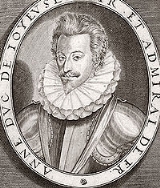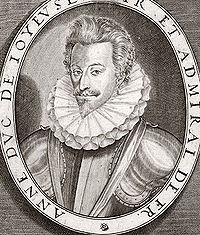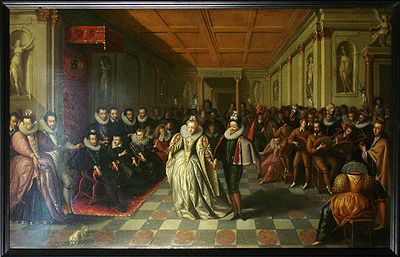
Anne de Joyeuse
Encyclopedia

Joyeuse, Ardèche
Joyeuse is a commune in the Ardèche department in the Rhône-Alpes region in southern France.-Geography:Joyeuse lies in the historic region of Bas-Vivarais, in the valley of the Beaume, a tributary of the Ardèche River.-Population:-Personalities:...
(1560 or 1561 – 20 October 1587) was a royal favourite
Favourite
A favourite , or favorite , was the intimate companion of a ruler or other important person. In medieval and Early Modern Europe, among other times and places, the term is used of individuals delegated significant political power by a ruler...
and active participant in the French Wars of Religion
French Wars of Religion
The French Wars of Religion is the name given to a period of civil infighting and military operations, primarily fought between French Catholics and Protestants . The conflict involved the factional disputes between the aristocratic houses of France, such as the House of Bourbon and House of Guise...
.
An intimate friend of Henry III of France
Henry III of France
Henry III was King of France from 1574 to 1589. As Henry of Valois, he was the first elected monarch of the Polish-Lithuanian Commonwealth with the dual titles of King of Poland and Grand Duke of Lithuania from 1573 to 1575.-Childhood:Henry was born at the Royal Château de Fontainebleau,...
, he was known as a minion and keeper of the king's chambers, with these serious responsibilities he also gained a number of privileges around the court such as wearing royal colors such as royal blue, purple, and red, also the right to wear jewelry of high majesties of the court such as a well known red ruby and diamond ring given to him by the king after having been taken away from Princesse Marguerite de Valois
Marguerite de Valois
Margaret of Valois was Queen of France and of Navarre during the late sixteenth century...
as a punishment for accusing Anne of trying to interfere with a meeting with a king as requested of her by Catherine de' Medici
Catherine de' Medici
Catherine de' Medici was an Italian noblewoman who was Queen consort of France from 1547 until 1559, as the wife of King Henry II of France....
, he was also a member of the circle of young courtiers known as Les Mignons
Les Mignons
Les Mignons was a term used by polemicists in the toxic atmosphere of the French Wars of Religion and taken up by the people of Paris, to designate the favourites of Henry III of France, from his return from Poland to reign in France in 1574, to his assassination in 1589, a disastrous end to which...
.
Anne was born in 1560 in the château de Joyeuse. He was the eldest son of Guillaume, 8th Vicomte de Joyeuse, the owner of the rights to the Bishopric of Alet and future Marshal of France
Marshal of France
The Marshal of France is a military distinction in contemporary France, not a military rank. It is granted to generals for exceptional achievements...
. Cardinal François de Joyeuse
François de Joyeuse
François de Joyeuse was a French churchman and politician.Born at Carcassonne, François de Joyeuse was the second son of Guillaume de Joyeuse and Marie Eléanor de Batarnay. As the younger son of a seigneur in an intensely religious family of bishops and soldiers, he was destined for a career in...
was his younger brother. He was reared in Toulouse
Toulouse
Toulouse is a city in the Haute-Garonne department in southwestern FranceIt lies on the banks of the River Garonne, 590 km away from Paris and half-way between the Atlantic Ocean and the Mediterranean Sea...
and attended the Collège de Navarre
Collège de Navarre
The College of Navarre was one of the colleges of the historic University of Paris, rivaling the Sorbonne and renowned for its library. It was founded by Queen Joan I of Navarre in 1305, who provided for three departments, the arts with 20 students, philosophy with 30 and theology with 20...
, starting in August 1572.

Languedoc
Languedoc is a former province of France, now continued in the modern-day régions of Languedoc-Roussillon and Midi-Pyrénées in the south of France, and whose capital city was Toulouse, now in Midi-Pyrénées. It had an area of approximately 42,700 km² .-Geographical Extent:The traditional...
and Auvergne
Auvergne (province)
Auvergne was a historic province in south central France. It was originally the feudal domain of the Counts of Auvergne. It is now the geographical and cultural area that corresponds to the former province....
. In 1579, he was put in charge of a compagnie d'ordonnance and was soon appointed governor of Mont Saint-Michel
Mont Saint-Michel
Mont Saint-Michel is a rocky tidal island and a commune in Normandy, France. It is located approximately one kilometre off the country's north-western coast, at the mouth of the Couesnon River near Avranches...
. In 1580, he took part in the siege of Fère-en-Tardenois
Fère-en-Tardenois
Fère-en-Tardenois is a commune in the Aisne department in Picardy in northern France, .-Population:-Personalities:It was the birthplace of Camille Claudel , sculptor and graphic artist.-Sights:...
.
The King arranged Joyeuse's marriage to his sister-in-law, Marguerite, daughter of Nicholas, Duke of Mercœur. The nuptials were celebrated on 18 September 1581 with unprecedented magnificence. King Henry used the marriage as a pretext for elevating his favourite to the dignity of Duc de Joyeuse. He was given precedence over all other dukes and peers of France, with the exception of princes of the blood. In addition to more than 300 000 écus in dowry, he was given the seigneury of Limours.
In the next year, the 21-year old mignon was made Grand-admiral de France (1 June) and commander in the Ordre du Saint-Esprit, the kingdom's highest (31 December). He was appointed governor of Normandy
Normandy
Normandy is a geographical region corresponding to the former Duchy of Normandy. It is in France.The continental territory covers 30,627 km² and forms the preponderant part of Normandy and roughly 5% of the territory of France. It is divided for administrative purposes into two régions:...
in 1583 and Le Havre
Le Havre
Le Havre is a city in the Seine-Maritime department of the Haute-Normandie region in France. It is situated in north-western France, on the right bank of the mouth of the river Seine on the English Channel. Le Havre is the most populous commune in the Haute-Normandie region, although the total...
in 1584. After the death of Duke François
François, Duke of Anjou
Francis, Duke of Anjou and Alençon was the youngest son of Henry II of France and Catherine de' Medici.-Early years:...
the Joyeuse brothers were allowed to govern the duchies of Anjou
Anjou
Anjou is a former county , duchy and province centred on the city of Angers in the lower Loire Valley of western France. It corresponds largely to the present-day département of Maine-et-Loire...
and Alençon
Alençon
Alençon is a commune in Normandy, France, capital of the Orne department. It is situated west of Paris. Alençon belongs to the intercommunality of Alençon .-History:...
in the name of the king.
His massacre of 800 Huguenots during a campaign in Poitou
Poitou
Poitou was a province of west-central France whose capital city was Poitiers.The region of Poitou was called Thifalia in the sixth century....
(the massacre de Saint-Eloi, 21 June 1587) incurred the displeasure of the King. He was received coldly at court and, anxious to be restored to Henry's favour, led royal troops against the king's arch-enemy, Henry of Navarre. He suffered a defeat at the hands of the Huguenots in the Battle of Coutras
Battle of Coutras
The Battle of Coutras, fought on 20 October 1587, was a major engagement in the eighth and final war of the French Religious Wars between an army under Henry of Navarre and a royal army led by Anne, Duke of Joyeuse...
and was taken prisoner. Although he offered a ransom of 100,000 écu
ECU
ECU may refer to:Automotive terms* Electronic control unit, a generic term for any embedded system that controls one or more of the electrical systems or subsystems in a motor vehicle...
s, Joyeuse was killed in revenge for the massacre of Saint-Eloi, as was his 18-year-old brother Claude, lord of Saint-Sauveur. He was childless and was succeeded as Duke of Joyeuse by another brother, François
François de Joyeuse
François de Joyeuse was a French churchman and politician.Born at Carcassonne, François de Joyeuse was the second son of Guillaume de Joyeuse and Marie Eléanor de Batarnay. As the younger son of a seigneur in an intensely religious family of bishops and soldiers, he was destined for a career in...
.

